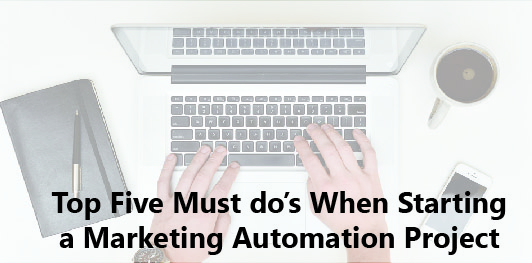Once you’ve decided that you need a marketing automation solution you have two choices: you can jump right in and starting setting it up and try to figure it out, or you can take a little time and plan the implementation. Most people will agree that taking some time is the right choice even though it is not always the way it happens in reality.
So when you’re ready to buy a marketing automation solution, consider these five things before you purchase and deploy.
Start by understanding your current process for marketing to your customers as well as the pieces you would like to add once you have a solution in place. Marketing Automation will help automate a lot of steps, but if there are problems in your marketing process, then the solution will only amplify them by automating bad processes. Have an understanding of the customer journey, which includes the steps a customer goes through while interacting with your company on a purchase path. Understanding the potential touch points allows you to define what the customer expects at each step and stage. Does the customer need an article that helps them understand the size of the problem, or do they need help justifying the costs, or maybe they need to talk to a salesperson to get a demo of your offering? Understanding the steps allows you to determine the content or actions needed at each point. Then you’ll be able to build a full process that will help a prospect move down the purchase path with the right information at the right time so that they can make a decision.
Deploying Marketing Automation cannot happen in a silo, as the results will not be ideal and the projects will often fail. Deploying a solution like this will require the cooperation of a variety of departments, most often including Marketing, Sales, and IT, but it can include other departments like BI or Decision Support, Operations, and others. To be an effective solution, marketing automation solutions often need to integrate with other solutions that are owned by IT or other departments. Make sure that data sources such as lead scoring models are based on data and insights from sales results. This will allow your automation process to be as close to reality as possible.
Marketing Automation can be complicated. There are a lot of moving parts to organize and manage when developing campaigns, but then you must apply all of those pieces to the technical solution that you purchased so that you can execute the campaign as you imagined. Hiring a partner with experience in marketing automation, or hiring a dedicated employee to own the marketing automation solution can greatly improve the results of any marketing automation program. Marketing departments are continually asked to do more with less, but this is an important step that you don’t want to skip. Having someone who understands the technical capabilities of your solution and also understands the art/science of marketing will prove invaluable as you begin to implement campaigns and get the most out of your system. An effective partner can help you short cut the process from starting to effectively running campaigns because they have experience and an understanding of the tools, theory, and execution.
Start with a simple campaign and build from it. You don’t have to build every campaign that your company currently does into the solution to get started. Pick something that easily lends itself to marketing automation and start there. A great starting point is automating a campaign around a trade show or event. There are two benefits to starting with a campaign like this. One, the campaign is usually short in duration so that you can set it up and run it and see results in a short amount of time. Secondly, the content needed is usually pretty well defined. You will likely have a message before the event inviting registrants to visit your booth or attend your session. Then you might have a message during the event encouraging people to stop by and enter to win your giveaway or inviting them to take some other action. Then, you can have a message that recaps the event and have it scheduled to send three days after the event ends. Additionally, you can load the list of attendees who visited your booth so that they get a personalized email thanking them for stopping by and encouraging them to take the next steps with your company.
These are straightforward content pieces that can be easily created, and set up easily into an automated campaign. This will give you results quickly and allow you to get your feet wet without much risk.
The final step, and perhaps the most important, is designed to focus and motivate your team throughout the process of implementing marketing automation. I’ll be blunt, it’s not always the easiest process. Implementing the technology might be straightforward, but changing the behaviors of users who are learning the system, developing campaigns, creating content, and most importantly, understanding how to get the most value out of your system will take time and energy. When starting the process as a team, create a vision statement and a why definition. The vision is what you want to accomplish with the project and includes the metrics that you want to affect. You don’t have to define the actual numbers, but ideally you should know how you plan to measure success. The why is the reason you are doing this project, the motivation, and the outcome that you hope to see as a result. This can be aspirational, but make sure to be realistic. Having agreement from your team will help you focus and make progress as you move through the entire process.
By taking some time to plan your marketing automation implementation you can help ensure that your project will be successful by being better prepared to leverage the power that a marketing automation solution provides to you and your team.






